Drought Forecasting for Decision Makers Using Water Balance Analysis and Deep Neural Network
Abstract
:1. Introduction
2. Study Area and Available Data
3. Methods
3.1. Conceptual Model (Water Balance Analysis)
3.1.1. Improvement of Water Demand Analysis
3.1.2. Improvement of Water Supply Analysis
3.1.3. MODSIM-DSS Model
3.2. Data-Driven Model (Deep Neural Networks)
4. Results
4.1. Drought Assessment
4.2. Drought Forecasting
5. Discussion and Conclusions
Author Contributions
Funding
Institutional Review Board Statement
Informed Consent Statement
Data Availability Statement
Conflicts of Interest
References
- World Meteorological Organization (WMO). Special Environment Report No. 5; WMO: Geneva, Switzerland, 1975; pp. 17–25. [Google Scholar]
- Hong, W.; Wilhite, D.A. An operational agricultural drought risk assessment model for Nebraska, USA. Nat. Hazards 2004, 33, 1–21. [Google Scholar]
- Mishra, A.K.; Singh, V.P. A review of drought concepts. J. Hydrol. 2010, 391, 202–216. [Google Scholar] [CrossRef]
- Zargar, A.; Sadiq, R.; Naser, B.; Khan, F.I. A review of drought indices. Environ. Rev. 2011, 19, 333–349. [Google Scholar] [CrossRef]
- McKee, T.B.; Doesken, N.J.; Kleist, J. The relationship of drought frequency and duration to time scales. In Proceedings of the 8th Conference on Applied Climatology, Anaheim, CA, USA, 17–22 January 1993. [Google Scholar]
- Palmer, W.C. Meteorological Drought. Research Paper No. 45; USA Department of Commerce Weather Bureau: Washington, DC, USA, 1965; pp. 1–58. [Google Scholar]
- Vicente-Serrano, S.M.; Begueria, S.; Lopez-Moreno, J.I. A multi-scalar drought index sensitive to global warming: The Standardized Precipitation Evapotranspiration Index. J. Clim. 2010, 23, 1696–1718. [Google Scholar] [CrossRef] [Green Version]
- Tsakiris, G.; Vangelis, H. Establishing a drought index incorporating evapotranspiration. Eur. Water 2015, 9, 3–11. [Google Scholar]
- Tsakiris, G. Drought risk assessment and management. Water Resour. Manag. 2017, 31, 3083–3095. [Google Scholar] [CrossRef]
- Intergovernmental Panel on Climate Change (IPCC). Climate Change 2014: Impacts, Adaptation, and Vulnerability; Contribution of Working Group II to the Fifth Assessment Report of the IPCC; Cambridge University Press: Cambridge, UK, 2014; p. 1048. [Google Scholar]
- Kim, J.S.; Park, S.Y.; Hong, H.P.; Chen, J.; Choi, S.J.; Kim, T.W.; Lee, J.H. Drought risk assessment for future climate projections in the Nakdong River Basin, Korea. Int. J. Climatol. 2020, 40, 4528–4540. [Google Scholar] [CrossRef]
- Pei, W.; Fu, Q.; Liu, D.; Li, T.; Cheng, K.; Cui, S. A novel method for agricultural drought risk assessment. Water Resour. Manag. 2019, 33, 2033–2047. [Google Scholar] [CrossRef]
- Kuntiyawichai, K.; Wongsasri, S. Assessment of drought severity and vulnerability in the Lam Phaniang River Basin, Thailand. Water 2021, 13, 2743. [Google Scholar] [CrossRef]
- Ortega-Gaucin, D.; Ceballos-Tavares, J.A.; Sánchez, A.O.; Castellano-Bahena, H.V. Agricultural drought risk assessment: A spatial analysis of hazard, exposure, and vulnerability in Zacatecas, Mexico. Water 2021, 13, 1431. [Google Scholar] [CrossRef]
- Yan, D.; Weng, B.; Wang, G.; Wang, H.; Yin, J.; Bao, S. Theoretical framework of generalized watershed drought risk evaluation and adaptive strategy based on water resources system. Nat. Hazards 2014, 73, 259–276. [Google Scholar] [CrossRef]
- Wilhite, D.A.; Svoboda, M.D. Drought Early Warning Systems in the Context of Drought Preparedness and Mitigation. In Early Warning Systems for Drought Preparedness and Drought Management; WMO: Geneva, Switzerland, 2000; pp. 1–21. [Google Scholar]
- Nam, W.H.; Choi, J.Y.; Yoo, S.H.; Jang, M.W. A decision support system for agricultural drought management using risk assessment. Paddy Water Environ. 2012, 10, 197–207. [Google Scholar] [CrossRef]
- Quijano, J.A.; Jaimes, M.A.; Torres, M.A.; Reinoso, E.; Castellanos, L.; Escamilla, J.; Ordaz, M. Event-based approach for probabilistic agricultural drought risk assessment under rainfed conditions. Nat. Hazards 2015, 76, 1297–1318. [Google Scholar] [CrossRef]
- Yue, Y.; Wang, L.; Li, J.; Zhu, A. An EPIC model-based wheat drought risk assessment using new climate scenarios in China. Clim. Change 2018, 147, 539–553. [Google Scholar] [CrossRef]
- Naumann, G.; Spinoni, J.; Vogt, J.V.; Barbosa, P. Assessment of drought damages and their uncertainties in Europe. Environ. Res. Lett. 2015, 10, 1–14. [Google Scholar] [CrossRef]
- Lim, J.D.; Yang, J.S. Possibility analysis of future droughts using long short term memory and standardized groundwater level index. J. Korea Water Resour. Assoc. 2020, 53, 131–140. [Google Scholar]
- Blauhut, V.; Gudmundsson, L.; Stahl, K. Towards pan-European drought risk maps: Quantifying the link between drought indices and reported drought impacts. Environ. Res. Lett. 2015, 10, 1–10. [Google Scholar] [CrossRef]
- Observed Meteorological Data. Available online: http://www.wamis.go.kr (accessed on 22 October 2020).
- RCP Scenarios. Available online: http://www.climate.go.kr (accessed on 5 November 2020).
- Population Census in 2015. Available online: https://kostat.go.kr/portal/eng/index.action (accessed on 5 November 2020).
- Land-Use Data (GIS Format). Available online: http://www.nsdi.go.kr/ (accessed on 14 November 2020).
- Tsakiris, G.; Nalbantis, I.; Vangelis, H.; Verbeiren, B.; Huysmans, M.; Tychon, B.; Jacquemin, I.; Canters, F.; Vanderhaegen, S.; Engelen, G.; et al. A system-based paradigm of drought analysis for operational management. Water Resour. Manag. 2013, 27, 5281–5297. [Google Scholar] [CrossRef]
- Ministry of Land, Infrastructure, and Transport (MOLIT). National Water Resources Plan (2001∼2020); Publication No. 11-1613000-001716-13; MOLIT: Sejong, Korea, 2016; pp. 198–233. [Google Scholar]
- K-Water. A Study on the Basic Plan for Water Management; Publication No. 11-B500001-000091-01; K-Water: Daejeon, Korea, 2008; pp. 233–287. [Google Scholar]
- Choi, S.J.; Kang, S.K.; Lee, D.R.; Kim, J.H. A study on water supply and demand prospects for water resources planning. J. Korean Soc. Hazard Mitig. 2018, 18, 589–596. [Google Scholar] [CrossRef] [Green Version]
- K-Water. K-MODSIM Manual; Ver. 1.1; K-Water: Daejeon, Korea, 2007; pp. 1–40. [Google Scholar]
- Lee, J.H.; Kim, C.J. Derivation of drought severity-duration-frequency curves using drought frequency analysis. J. Korea Water Resour. Assoc. 2011, 44, 889–902. [Google Scholar] [CrossRef] [Green Version]
- Cook, E.R.; Woodhouse, C.A.; Eakin, C.M.; Meko, D.M.; Stahle, D.W. Long-term aridity changes in the western United States. Science 2004, 306, 1015–1018. [Google Scholar] [CrossRef] [PubMed] [Green Version]
- Kim, J.E.; Yu, J.S.; Lee, J.H.; Kim, T.W. Drought risk analysis in Seoul using Cheugugi and climate change scenario based rainfall data. J. Korea Water Resour. Assoc. 2018, 38, 387–393. [Google Scholar]
- Neural Networks and Deep Learning. Available online: http://neuralnetworksanddeeplearning.com (accessed on 10 October 2020).
- Korea Institute of Civil Engineering and Building Technology (KICT). Investigating Report for the Drought in 1995; KICT: Goyang, Korea, 1995. [Google Scholar]
- Korea Rural Community Corporation (KRC). White Book for the Drought in 2012; KRC: Naju, Korea, 2012. [Google Scholar]
- MOLIT. Investigating Report for the Drought in 2015; MOLIT: Sejong, Korea, 2016. [Google Scholar]
- National Drought Information-Analysis Center(NDIC). Drought assessment and forecasting. In Response Guidebook for Drought Disaster; NDIC: Sejong, Korea, 2016; p. 117. [Google Scholar]
- Oh, J.H.; Kim, Y.S.; Ryu, K.S.; Bae, Y.D. Comparison and discussion of water supply and demand forecasts considering spatial resolution in the Han-river basin. J. Korea Water Resour. Assoc. 2019, 52, 463–473. [Google Scholar]
- Oh, J.H.; Kim, Y.S.; Ryu, K.S.; Jo, Y.S. Comparison and discussion of MODSIM and K-WEAP model considering water supply priority. J. Korea Water Resour. Assoc. 2019, 52, 505–514. [Google Scholar]
- Choi, S.J.; Lee, D.R.; Kang, S.K. Analysis of water supply capacity based on future various scenarios in Geum river basin. J. Korean Soc. Hazard Mitig. 2018, 19, 315–321. [Google Scholar] [CrossRef] [Green Version]
- Papadimos, D.; Demertzi, K.; Papamichail, D. Assessing lake response to extreme climate change using the coupled MIKE SHE/MIKE 11 Model: Case Study of Lake Zazari in Greece. Water 2022, 14, 921. [Google Scholar] [CrossRef]
- Ashu, A.B.; Lee, S.-I. Assessing climate change effects on water balance in a monsoon watershed. Water 2020, 12, 2564. [Google Scholar] [CrossRef]
- Hutton, P.H.; Meko, D.M.; Roy, S.B. Supporting restoration decisions through integration of tree-ring and modeling data: Reconstructing flow and salinity in the San Francisco estuary over the past millennium. Water 2021, 13, 2139. [Google Scholar] [CrossRef]
- Alsumaiei, A.A.; Alrashidi, M.S. Hydrometeorological drought forecasting in hyper-arid climates using nonlinear autoregressive neural networks. Water 2020, 12, 2611. [Google Scholar] [CrossRef]
- Myronidis, D.; Ioannou, K.; Fotakis, D.; Dörflinger, G. Streamflow and hydrological drought trend analysis and forecasting in Cyprus. Water Resour. Manag. 2018, 32, 1759–1776. [Google Scholar] [CrossRef]
- Belayneh, A.; Adamowski, J.; Khalil, B.; Ozga-Zielinski, B. Long-term SPI drought forecasting in the Awash River basin in Ethiopia using wavelet neural network and wavelet support vector regression models. J. Hydrol. 2014, 508, 418–429. [Google Scholar] [CrossRef]
- So, J.-M.; Lee, J.-H.; Bae, D.-H. Development of a hydrological drought forecasting model using weather forecasting data from GloSea5. Water 2020, 12, 2785. [Google Scholar] [CrossRef]
- Fundel, F.; Jörg-Hess, S.; Zappa, M. Monthly hydrometeorological ensemble prediction of streamflow droughts and corresponding drought indices. Hydrol. Earth Syst. Sci. 2013, 17, 395–407. [Google Scholar] [CrossRef] [Green Version]
- Sheffield, J.; Wood, E.F.; Chaney, N.; Guan, K.; Sadri, S.; Yuan, X.; Olang, L.; Amani, A.; Ali, A.; Demuth, S. A drought monitoring and forecasting system for sub-Sahara African water resources and food security. Bull. Am. Meteorol. Soc. 2014, 95, 861–882. [Google Scholar] [CrossRef]
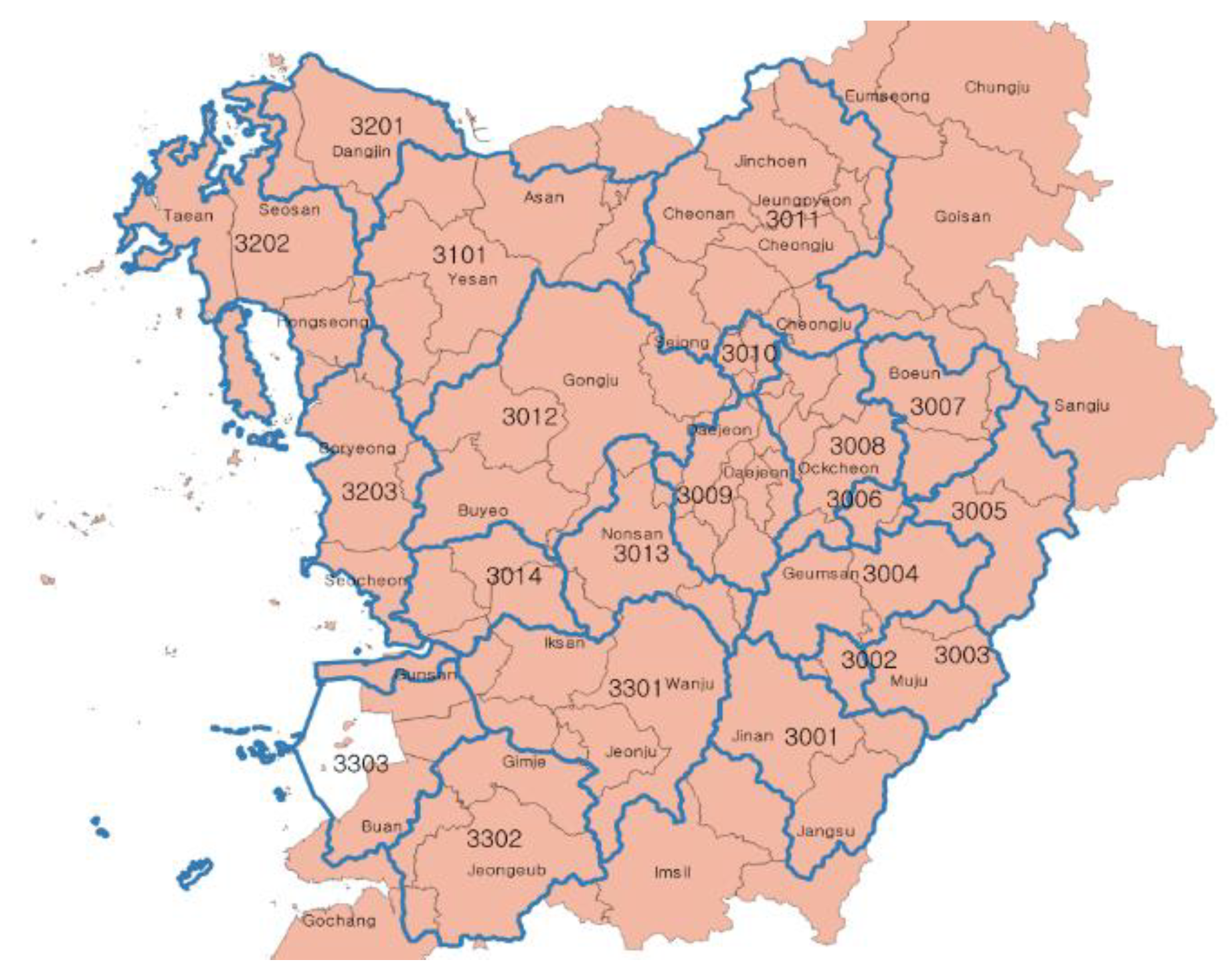
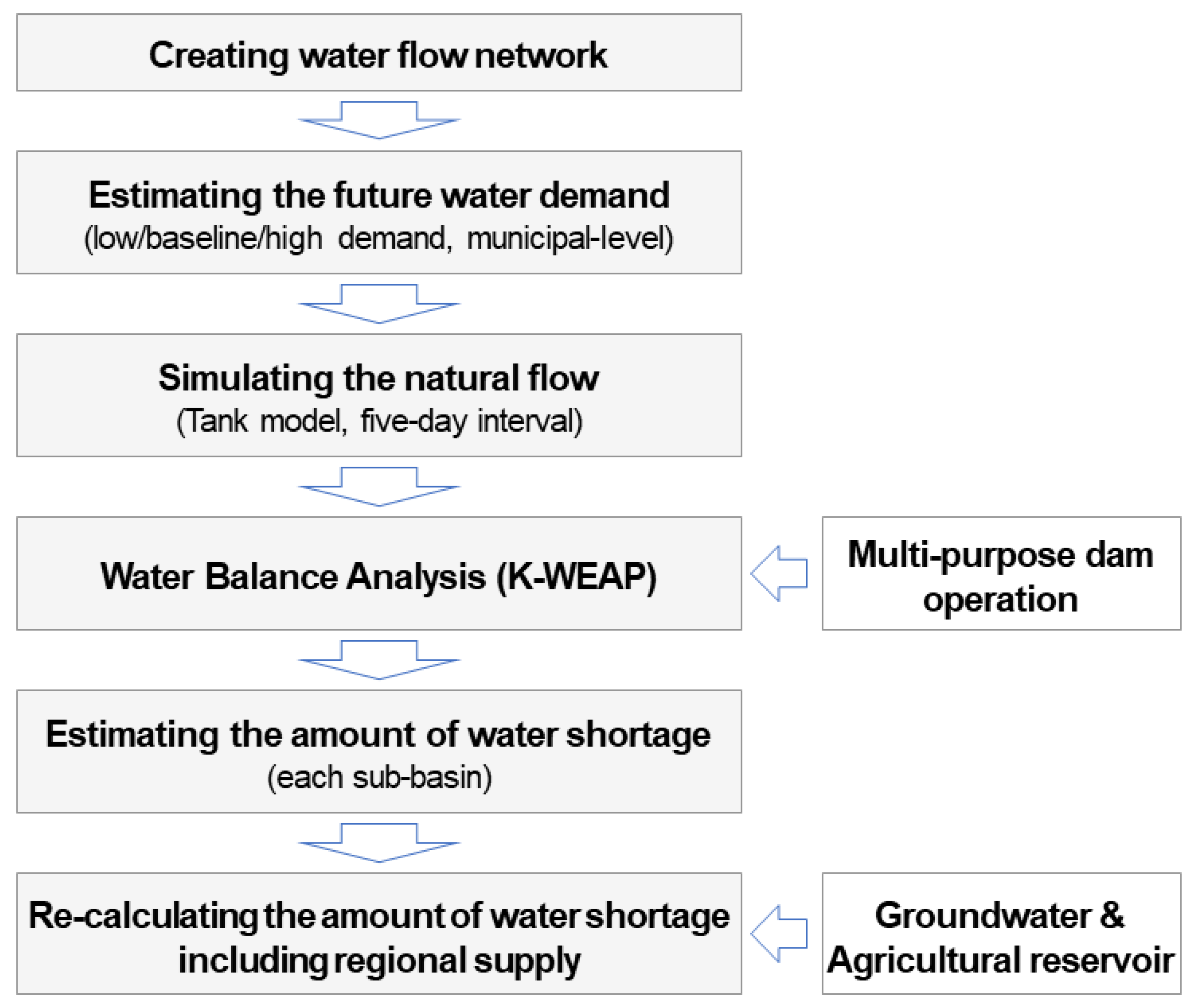
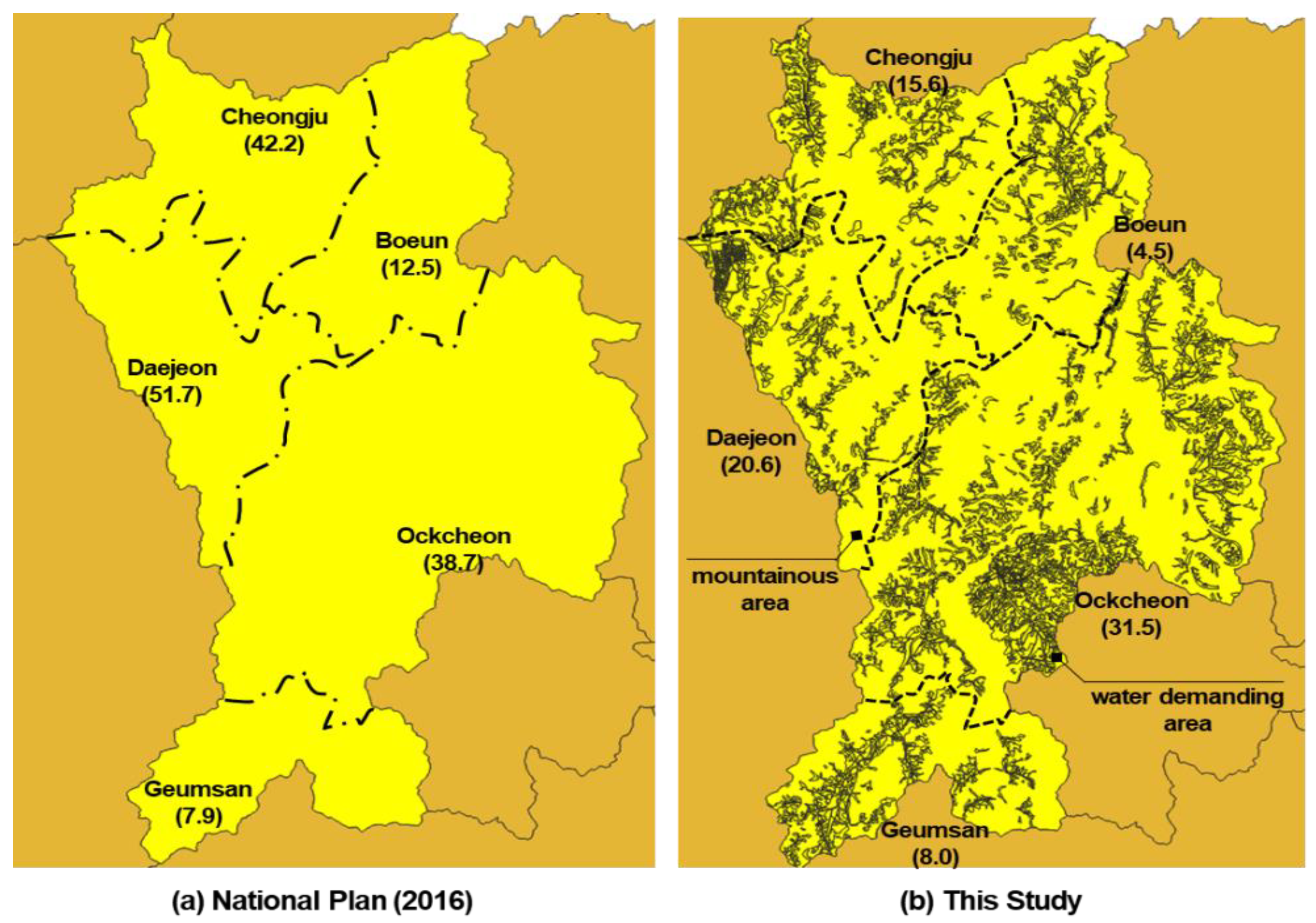
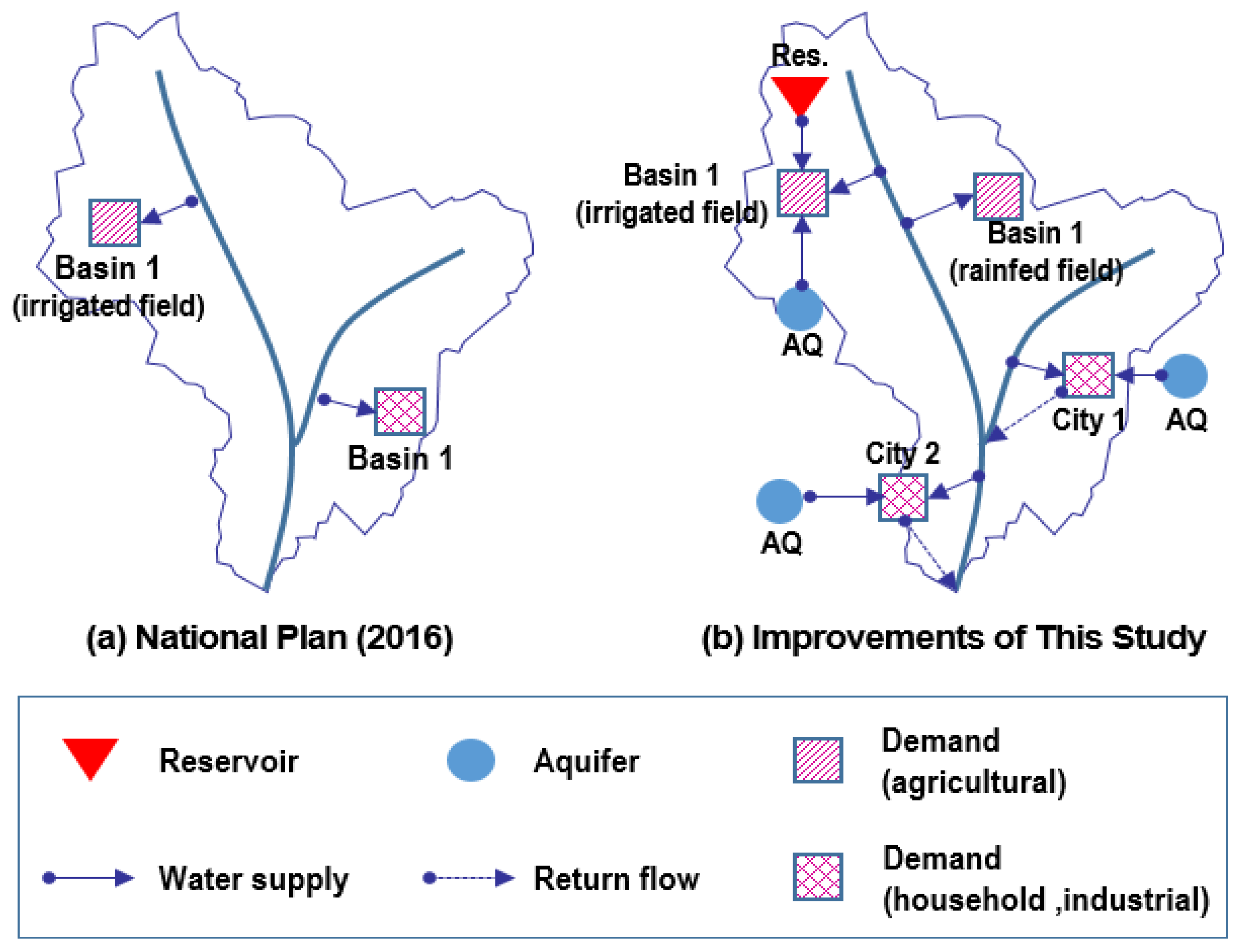


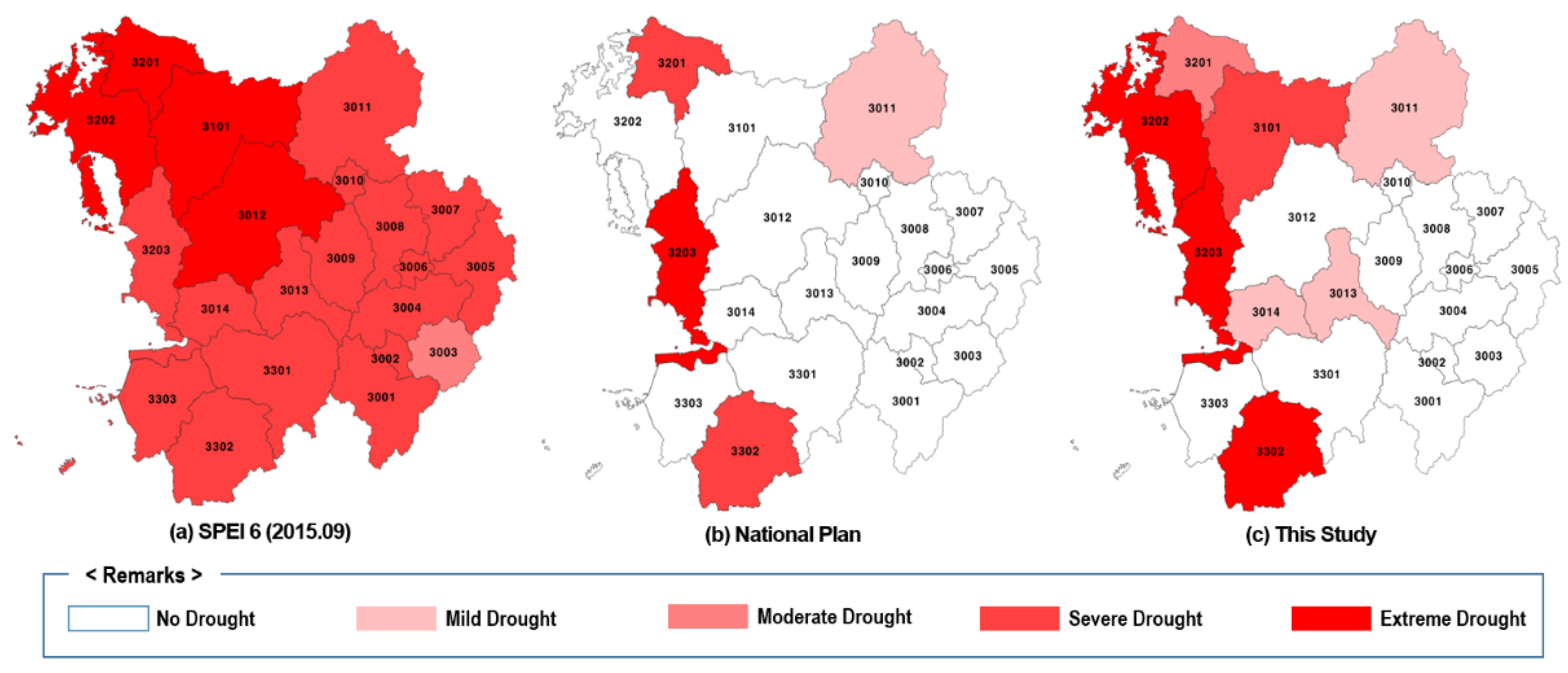
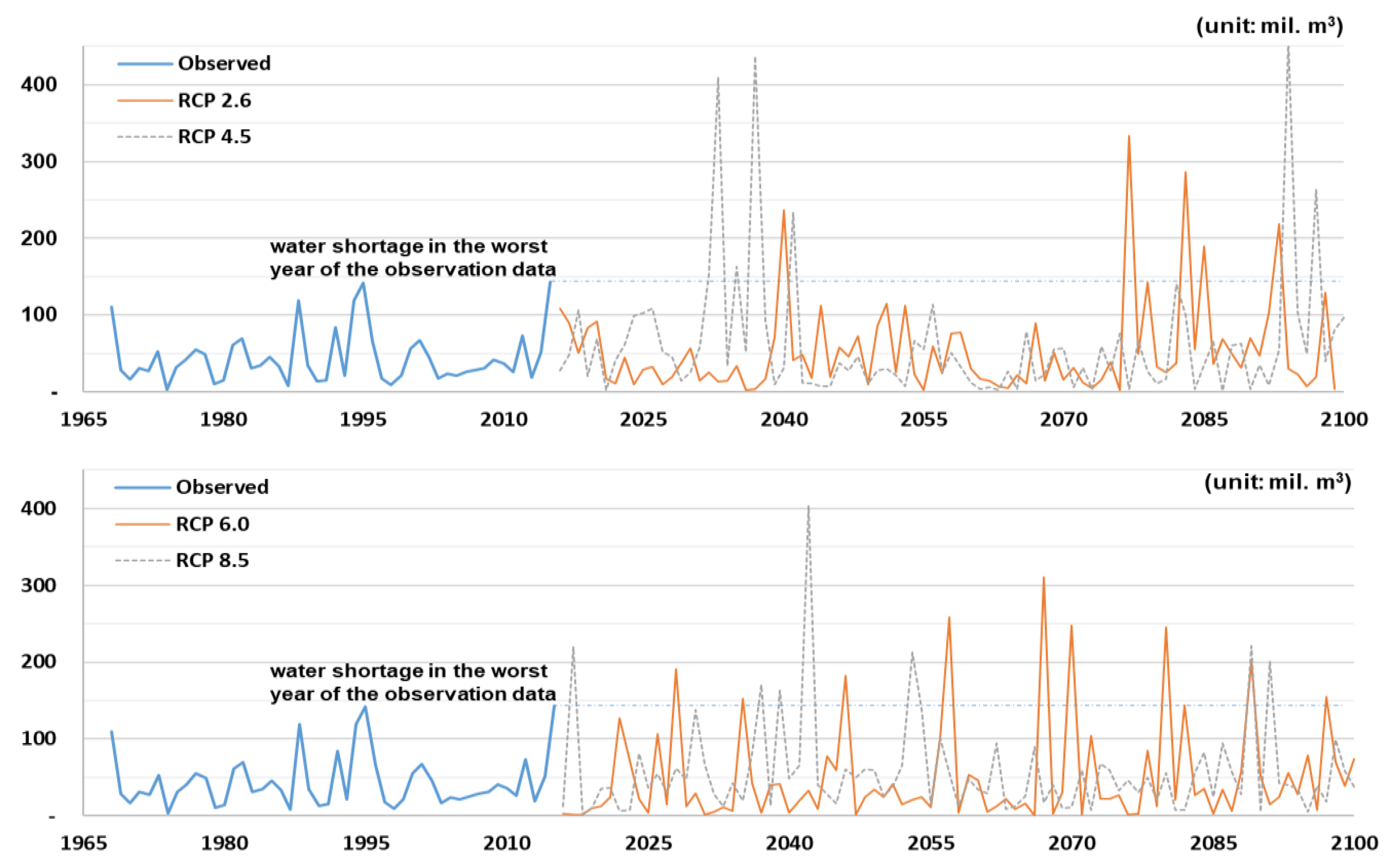



| Category | Available Data | Sources |
|---|---|---|
| Observed Meteorological Data | Rainfall, evapotranspiration
| Water Resources Management Information System [23] |
| RCP Scenario | RCP 2.6, 4.5, 6.0, and 8.5 Rainfall, maximum and minimum temperature, relative humidity, and wind velocity
| Korea Meteorological Administration [24] |
| Population | Population Census in 2015 (37 districts) | Korea National Statistical Office [25] |
| Land-use | GIS format (1:25,000, 37 districts) | National Spatial Data Infrastructure Portal [26] |
| National Plan | Improvements of This Study | ||
|---|---|---|---|
| Flow Network | Agricultural demand | One node in the sub-basin | One node in the sub-basin |
| Household and Industrial demand | One node in the sub-basin | Separate nodes for each district in the sub-basin | |
| Water Demand | Demand estimation | Equation. (2) adopted - household, agricultural, industrial : district area ratio | Equation (3) adopted - household : population living in the sub-basin - agricultural, industrial : related area in the sub-basin |
| Demand for the rainfed farming | Not included | Included | |
| Water Supply | Agricultural reservoir and confined aquifer | After the K-WEAP simulation, the water shortage is reduced as much as the supplies from both sources | Both supplies are included in the simulation |
| Intake and sewage treatment plant | Location and capacity are not considered | Location and capacity are considered in the simulation | |
| Simulation result | Annual water shortage | Water shortage in each simulation step | |
| Category | Mckee et al. (1993) [5] | This Study (Water Shortage) | |
|---|---|---|---|
| SPI | Severity of Event | ||
| Mild dryness | 0 to −0.99 | 1 in 3 years | 0–5 mil. m3/year |
| Moderate dryness | −1.00 to −1.49 | 1 in 10 years | 5–10 mil. m3/year |
| Severe dryness | −1.50 to −1.99 | 1 in 20 years | 10–30 mil. m3/year |
| Extreme dryness | over −2.00 | 1 in 50 years | over 30 mil. m3/year |
| Sub-Basin | Case | Process (Adopted Data) | MSE | Correlation Coefficient |
|---|---|---|---|---|
| 3101 | 1 | Training (Past, 1967–2005) | 0.019 | 0.791 |
| Inference (Past, 2006–2015) | 0.034 | 0.529 | ||
| 2 | Training (RCP, 2011–2100) | 0.017 | 0.837 | |
| Inference (Past, 2006–2015) | 0.018 | 0.826 | ||
| 3202 | 1 | Training (Past, 1967–2005) | 0.033 | 0.749 |
| Inference (Past, 2006–2015) | 0.033 | 0.630 | ||
| 2 | Training (RCP, 2011–2100) | 0.032 | 0.830 | |
| Inference (Past, 2006–2015) | 0.019 | 0.818 |
Publisher’s Note: MDPI stays neutral with regard to jurisdictional claims in published maps and institutional affiliations. |
© 2022 by the authors. Licensee MDPI, Basel, Switzerland. This article is an open access article distributed under the terms and conditions of the Creative Commons Attribution (CC BY) license (https://creativecommons.org/licenses/by/4.0/).
Share and Cite
Jang, O.-J.; Moon, H.-T.; Moon, Y.-I. Drought Forecasting for Decision Makers Using Water Balance Analysis and Deep Neural Network. Water 2022, 14, 1922. https://doi.org/10.3390/w14121922
Jang O-J, Moon H-T, Moon Y-I. Drought Forecasting for Decision Makers Using Water Balance Analysis and Deep Neural Network. Water. 2022; 14(12):1922. https://doi.org/10.3390/w14121922
Chicago/Turabian StyleJang, Ock-Jae, Hyeon-Tae Moon, and Young-Il Moon. 2022. "Drought Forecasting for Decision Makers Using Water Balance Analysis and Deep Neural Network" Water 14, no. 12: 1922. https://doi.org/10.3390/w14121922
APA StyleJang, O.-J., Moon, H.-T., & Moon, Y.-I. (2022). Drought Forecasting for Decision Makers Using Water Balance Analysis and Deep Neural Network. Water, 14(12), 1922. https://doi.org/10.3390/w14121922








